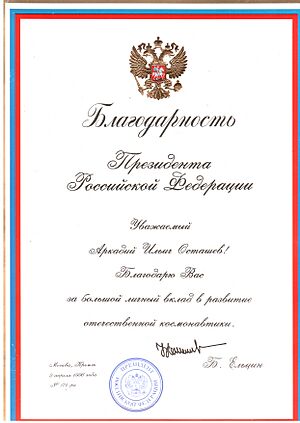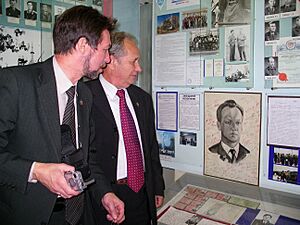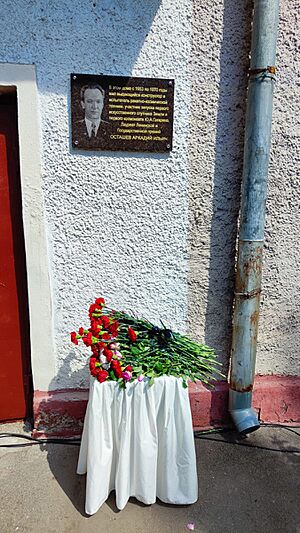Arkady Ostashev facts for kids
{{Infobox engineer | honorific_prefix = | name = Arkady Ostashev | honorific_suffix = | image = Arkady Ilyich Ostashev.jpg | image_size = 250px | alt = | caption = | native_name_lang = ru | nationality = Russian | citizenship =![]() Russia | birth_name =Arkady Ilyich Ostashev | birth_date = 30 September 1925 | birth_place = Maloye Vasilyevo, Noginsky District, Moscow Oblast, Soviet Union | death_date = 12 July 1998 (aged 72) | death_place = Moscow, Russia | resting_place = | resting_place_coordinates = | education = Candidate of Sciences | spouse = | parents = | children = | discipline = Engineering (mechanical) | institutions = Moscow Aviation Institute | employer = RSC Energia | significant_projects = Soviet space program | significant_design = Sputnik program
Russia | birth_name =Arkady Ilyich Ostashev | birth_date = 30 September 1925 | birth_place = Maloye Vasilyevo, Noginsky District, Moscow Oblast, Soviet Union | death_date = 12 July 1998 (aged 72) | death_place = Moscow, Russia | resting_place = | resting_place_coordinates = | education = Candidate of Sciences | spouse = | parents = | children = | discipline = Engineering (mechanical) | institutions = Moscow Aviation Institute | employer = RSC Energia | significant_projects = Soviet space program | significant_design = Sputnik program
Vostok program | significant_advance = | significant_awards =![]()
![]() Order of Lenin
Order of Lenin
![]()
![]() Order of the Red Banner of Labor
Order of the Red Banner of Labor
Lenin Prize
![]() USSR State Prize
USSR State Prize
Arkady Ilyich Ostashev (Russian: Аркадий Ильич Осташев; born September 30, 1925 – died July 12, 1998) was an important Russian and Soviet engineer and scientist. He played a key role in the early Soviet space program. Arkady Ostashev helped design many rocket engines and control systems for Soviet satellites. He was involved in launching the first artificial satellite into space. He also helped with the flight of Yuri Gagarin, the first human in space.
Ostashev earned a degree called Candidate of Technical Sciences. He was also an associate professor. He received the Lenin Prize in 1960 and the USSR State Prize in 1979. He was one of the main leaders at OKB-1, a famous rocket technology company. He was a student and close colleague of Sergei Korolev, who is known as the chief designer of the Soviet space program.
Contents
Early Life and Education
Arkady Ostashev was born in the village of Maloye Vasilyevo. When he was in school, Arkady and his older brother, Yevgeny, built a telescope. They used instructions from a magazine called "Knowledge is Power." This telescope could magnify things 10 times. They used it to observe the Moon [1]. They often dreamed of flying to other planets in our Solar System.
In 1942, Arkady finished 9th grade at Middle School No. 32 in Elektrougli. After school, he took a short course at the Moscow Aviation Institute (MAI). He passed exams that allowed him to join MAI. During his fourth year at the institute, Arkady studied German documents about rocket technology. These documents were brought back from Germany after World War II.
Studying these German designs helped Arkady decide on his final project for graduation. His project was about a "Composite Rocket with a winged last stage." He worked on this project under the guidance of Sergei Korolev.
Career in Space Technology
From 1947 until he graduated in 1948, Arkady Ostashev worked at a special design bureau. This bureau was part of the Research Institute-88. He started as a senior technician. He continued to work at this company, which later became RSC Energia, for over 50 years. He held many roles, from engineer to head of a large department [2].
In 1952, he completed advanced engineering courses at BMSTU. He also finished studies at the University of Marxism–Leninism. In 1956, Arkady joined the CPSU.
Arkady Ostashev's work focused on developing and testing missile and space systems. He helped create the testing plans for the famous "SEVEN" R-7 rocket. This rocket was very important for the Soviet space program. He wrote and co-wrote over 200 scientific papers and inventions [3].
In 1975, Arkady Ostashev led the rocket-space system tests for the "ASTP" [4]. This was a historic joint space mission between the Soviet Union and the United States. Besides his engineering work, he also taught. From 1964, he was an associate professor at the Moscow Aviation Institute. He gave lectures at Department No. 308.
Later Life and Legacy
Arkady Ostashev passed away on July 12, 1998, in Moscow. He wished to be cremated and buried with his older brother, Yevgeny. Yevgeny had died in a rocket accident on October 24, 1960. This accident happened at Site 41 of the Baikonur cosmodrome [5]. It occurred during preparations for the launch of the R-16 intercontinental ballistic missile.
In December 1998, Arkady's wife and son took his ashes to Baikonur (city) in Kazakhstan. He was buried next to his brother Yevgeny.
Family
- Wife: Lyudmila Vasilyevna Ostasheva (born Vasilyeva) (1924-2003). They married in 1949.
- Daughter: Olga Arkadyevna Ostasheva (born in 1951).
- Son: Mikhail Arkadyevich Ostashev (born in 1956).
Awards and Recognition
Arkady Ostashev received many awards for his important work:
- Order of the Red Banner of Labour (1956): For his efforts in creating long-range ballistic missiles.
- Order of Lenin (1957): For helping create and launch the first artificial satellite of Earth. He also received a medal from the USSR Academy of Sciences for this achievement.
- Lenin Prize (1960): For discovering and studying Earth's outer radiation belt. Also for studying the magnetic fields of Earth and the Moon.
- Order of Lenin (1961): For successfully creating rocket technology and the Vostok satellite spacecraft. This award was also for the world's first human spaceflight with Yuri Gagarin.
- Order of the Red Banner of Labour (1976): For his part in the joint Soyuz-Apollo space flight.
- USSR State Prize (1979): For his work in space research. This included creating and using methods to test Progress cargo ships.
- Medal "For Valiant Labour in the Great Patriotic War 1941–1945"
- Medal "Veteran of Labour"
- Jubilee Medal "In Commemoration of the 100th Anniversary of the Birth of Vladimir Ilyich Lenin"
- Other medals.
- Gratitude from the President of Russia (1996): For his significant personal contribution to the development of Russian space travel.
Because of his achievements, Ostashev was given a special personal pension by the government [6].
Remembering Arkady Ostashev
There are several places where Arkady Ostashev is remembered:
- At the museum at Site No. 2 of the Baikonur cosmodrome, there is an exhibit dedicated to him.
- In Elektrougli, where he grew up, the local history museum has a display about the Ostashev brothers.
- A memorial plaque is placed on the house where he lived as a child.
- The Memorial Museum of Cosmonautics in Moscow keeps documents from Arkady Ostashev's personal collection.
- The Museum of RSC "Energia", where he worked for over 50 years, also has materials about him.
- In 1993, documents from Ostashev's personal archives were placed in the Russian state archive for scientific-technical documentation.
- A memorial plaque for Arkady Ilyich has been put on the building at No. 17 Tsiolkovsky Street in the city of Korolev [7].




